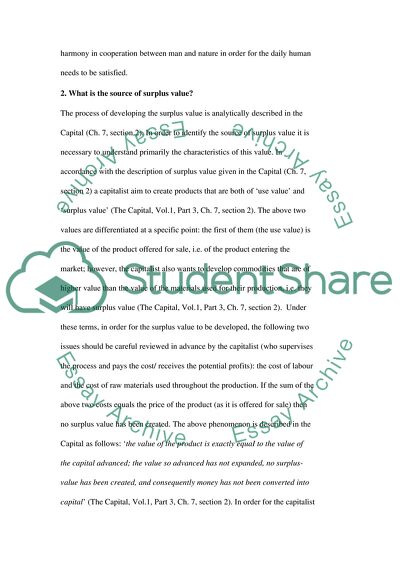
- Home
- Free Samples
- Premium Essays
- Editing Services
- Extra Tools
- Essay Writing Help
- About Us
- Studentshare
- Subjects
- Miscellaneous
- Reading: Passages from Marx and Engels: The Communist Manifesto and Marx Capital
Reading: Passages from Marx and Engels: The Communist Manifesto and Marx Capital - Essay Example

- Subject: Miscellaneous
- Type: Essay
- Level: Undergraduate
- Pages: 4 (1000 words)
- Downloads: 0
- Author: amonahan
Extract of sample "Reading: Passages from Marx and Engels: The Communist Manifesto and Marx Capital"
labour of the seller; in other words, the capitalist ‘buys labour-power in order to use it and consumes it by setting the seller of it to work’ (Marx, Vol., 1, Part 3, Ch. 7). Another important feature of the labour process described by Marx in the Capital is that fact that the above process is based on the cooperation between man and nature; the methodologies/ techniques used by man in work (throughout the production process) are in accordance with the rules of Nature – in terms that the needs of the natural environment have to be taken into consideration in order for the availability of the raw material to be guaranteed for the future.
From another point of view – highlighted in the Capital – the participation of the Nature in the labour process can be interpreted using the following framework: the man works using his body – which is part of the nature – and in this way the labour process represents the harmony in cooperation between man and nature in order for the daily human needs to be satisfied. The process of developing the surplus value is analytically described in the Capital (Ch. 7, section 2). In order to identify the source of surplus value it is necessary to understand primarily the characteristics of this value.
In accordance with the description of surplus value given in the Capital (Ch. 7, section 2) a capitalist aim to create products that are both of ‘use value’ and ‘surplus value’ (The Capital, Vol.1, Part 3, Ch. 7, section 2). The above two values are differentiated at a specific point: the first of them (the use value) is the value of the product offered for sale, i.e. of the product entering the market; however, the capitalist also wants to develop commodities that are of higher value than the value of the materials used for their production, i.e. they will have surplus value (The Capital, Vol.
1, Part 3, Ch. 7, section 2). Under these terms, in order for the surplus value to be developed, the following two issues should
...Download file to see next pages Read MoreCHECK THESE SAMPLES OF Reading: Passages from Marx and Engels: The Communist Manifesto and Marx Capital
Relevance of Marxism to Todays Economy
How phylosophers contribute to build western civilisation
Today's World and Our Search for Ultimate Meaning
The Eventual Belief in the Right of Western Ideals Over All Other Ideologies
The Theory of Ideology
Elite's Theory and Marxism Theory in Power and Politics
The Ways in Which Marx and Weber Understand the Nature of Capitalism
What Do Marx and Marxists Say on Law and Justice

- TERMS & CONDITIONS
- PRIVACY POLICY
- COOKIES POLICY